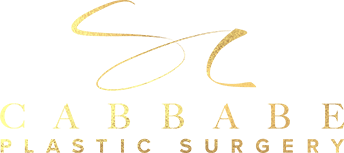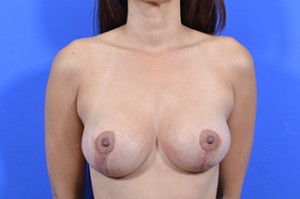Breast Implant Revision Surgery
Conveniently located to serve St. Louis, Missouri
 Dr. Cabbabe is a breast specialist and a large portion of his practice involves breast implant revision surgery from other plastic surgeons. Women may seek breast implant revision surgery for many reasons: a change in size is desired, rupture of an implant, deflation of an implant, capsular contractures, droopiness of the breasts over the implant, displacement of the implants, double bubbles, rippling over the implants.
Dr. Cabbabe is a breast specialist and a large portion of his practice involves breast implant revision surgery from other plastic surgeons. Women may seek breast implant revision surgery for many reasons: a change in size is desired, rupture of an implant, deflation of an implant, capsular contractures, droopiness of the breasts over the implant, displacement of the implants, double bubbles, rippling over the implants.
In cases of capsular contracture or silicone implant rupture, Dr. Cabbabe believes that most patients need their breast capsules removed. These are thick and irregularly scarred capsules that often times prevent the breast from being naturally soft and pliable. If a previous implant was placed above the chest muscle (sub-glandular), Dr. Cabbabe makes every effort possible to place the implant below the chest muscle (sub-pectoral). This reduces the risk of capsular contracture, keeps the breast implant in good position and increases the thickness of the tissue over the implant to reduce rippling. If the implant was sub pectoral and out of position, Dr. Cabbabe may make a new sub pectoral pocket (neo-pectoral pocket).
Dr. Cabbabe is an innovator and will formulate a plan with every patient to address their concerns in a financially sensitive manner. While some plastic surgeons will do the minimum necessary to address patient issues, Dr. Cabbabe takes the extra step needed in performing surgery to ensure that the results are natural and long – lasting in order to minimize the need for further revision surgeries down the road.
Dr. Cabbabe may recommend the use of mesh (human skin, pig skin or other synthetic mesh) to keep the implant in the correct position. This is useful in the setting of implants that were sub glandular and need to be converted to a sub muscular position where the concern is that the implant may work its way back into the sub glandular space. This is also helpful in the setting of a sub pectoral capsular contracture where the pocket may be quite wide after capsule removal and the implant has a tendency to want to slip into the armpit. Mesh can also be used to thicken the tissues over the implant to reduce rippling. Fat transfer procedures may also be used to thicken the tissues in this manner or produce more cleavage or address double bubble formation.
Dr. Cabbabe is sensitive to financial concerns and takes every effort possible to see if implant manufacturers may warranty any of the implants or portion of the surgery. He also keeps finances in mind when recommending the need for mesh which can be quite expensive and may have additional risk factors.
Preparing for Surgery
Dr. Cabbabe will ask that you refrain from taking any aspirin, plavix, Coumadin, ibuprofen or any other type of blood thinner. If you are older than 40, a mammogram within one year prior to the procedure is recommended as part of normal health screening. You will have an opportunity to try implants of various sizes inside a bra which will help you determine which size implant is best for you. Dr. Cabbabe will also measure your chest width to help you determine the best fit and shape for you.
Before & After Gallery
View before-and-after pictures of real patients of Cabbabe Plastic Surgery
Surgery
Incisions are made based on pre-operative markings and planning. A lift may be incorporated as needed depending on the droopiness of the breast or the location of the nipple – areola. Most of the time the final implants is placed underneath the muscle on the chest. Mesh and fat transfer procedures are done as needed based on the consultation.
Breast implant revision surgery takes around 1 1/2 – 3 hours, depending on the extent of the procedure. Antibiotics are given before and after the procedure, drains are generally incorporated and no massaging is generally recommended. Patients are able to shower the next day and go home in a bra. Early range of motion is done with the arms. Patients will generally follow-up within 1 day to 1 week and then approximately 3-4 weeks later and then in several months. Drains are removed 1-2 weeks after surgery depending on the extent of the procedure.
Nipple sensation and the ability to lactate are usually preserved in these procedures. Women are able to get mammograms after surgery and implants to do not interfere with breast cancer detection.
Your Breast Implant Revision Surgery will be performed in a hospital or surgery center in St. Louis, MO.
Recovery
Recovery is approximately 1-2 weeks depending on the extent of the procedure and the type of work one does. Most women who have this procedure done will be up and about the next day, moving around although they may need pain medication occasionally, but most women state it was not as bad as they anticipated and most of them, if they’ve had it done on a Thursday or Friday, can usually return to work within 1 week.
Dr. Cabbabe strives to make the procedure as easy and comfortable as possible for his patients. Before surgery, patients usually receive anti-inflammatory pain medications that do not cause bleeding. At the time of surgery, local anesthesia numbing medicine is used that is long – lasting into the breast. After surgery, early range of motion is begun and pain medications are given. Dr. Cabbabe does not believe in the use of pain pumps for breast augmentation as studies have shown mixed results with their use, they are costly and they increase the risk of infections. Dr. Cabbabe has removed breast implants on patients from other practices that use pain pumps due to infection.
Complications
The complications that can occur are infections of the implant or mesh (if used), rarely requiring the implant to be removed, or bleeding into the pocket around the implant requiring further surgery to evacuate blood or stop bleeding. Most women have some asymmetry to their breasts and most of the time the same sized implant is used on both sides but occasionally a different size implant will be used if needed. More breast tissue can be removed from the larger breast or a larger implant can be used on the smaller breast.
The greatest risk with breast revision surgery is the need for further revisions. In select patients, this rate can approach up to 25%. This includes patients with ruptured silicone implants with capsular contractures if no mesh is used, patients with conversion of an implant from sub glandular to sub muscular position or in patients with very droopy breasts requiring concomitant lifts. For this reason, Dr. Cabbabe will discuss this possibility and may recommend two – stage surgery in select patients.
Capsular contractures can occur although this has become less common in Dr. Cabbabe’s experience. An implant may rupture and further surgery would be needed during their lifetime. Finally, there are rare cancers, referred to ALCL, which have been linked to breast implants. Fortunately, these are rare and are still case reportable. They have been found in women who present with fluid around their implants after breast implant surgery.


